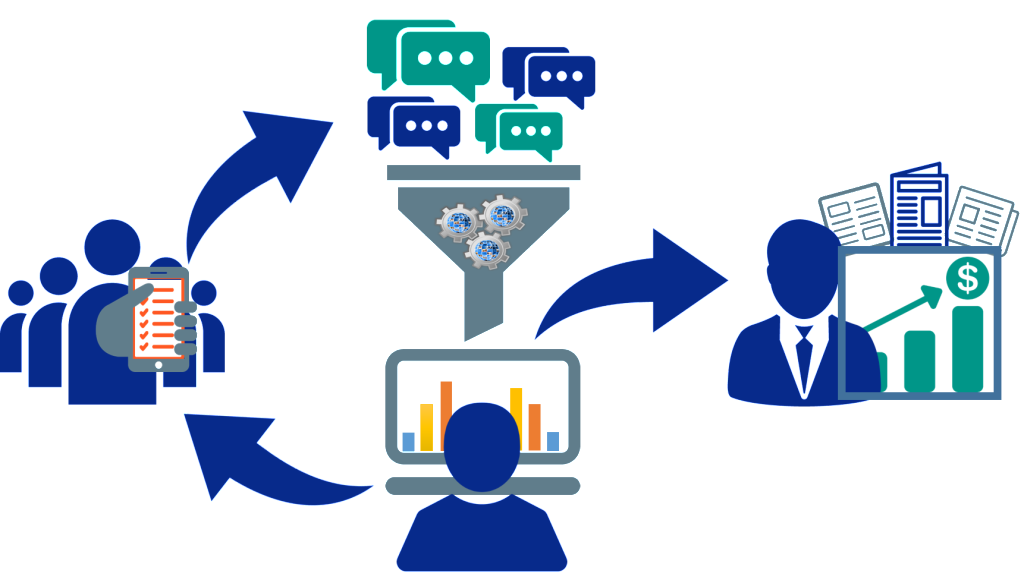Learning
The Power of Charts in Survey Data Analysis

In today’s data-centrist world, surveys play a pivotal role in gathering valuable information and insights from diverse audiences. However, analyzing raw survey data analysis can be a challenging endeavor, as it often involves dealing with vast amounts of information in various formats.
To unlock the full potential of survey data and gain meaningful insights, data visualization through charts emerges as an indispensable tool. In this blog, we will explore the best charts to analyze survey data effectively and reveal valuable insights that drive informed decision-making.
What is Survey Data Analysis?
Survey data refers to the information collected through surveys, which are structured questionnaires or interviews designed to gather specific data from a target group of individuals or respondents. Surveys are commonly used in various fields, including market research, social sciences, education, healthcare, and business, to gather insights, opinions, attitudes, and behaviors of the surveyed population.
Survey data can be collected using different methods, such as online surveys, phone interviews, face-to-face interviews, or paper-based questionnaires. The data obtained from surveys can be quantitative (numerical) or qualitative (descriptive or textual).

Types of Survey Data:
- Quantitative Data: Quantitative survey data consists of responses that are numerical and measurable. These responses are typically obtained from closed-ended questions, where respondents select from predetermined options. Examples of quantitative data include age, income, ratings on a scale, and the number of products purchased.
- Qualitative Data: Qualitative survey data involves non-numeric responses that provide descriptive information. This type of data is collected from open-ended questions, allowing respondents to express opinions, attitudes, and experiences in their own words. Qualitative data is valuable for gaining deeper insights into people’s thoughts and perceptions.
- Categorical Data: Categorical data is a subset of qualitative digital data that involves responses that can be grouped into categories. This data type often comes from questions with options like gender, ethnicity, education level, or product preferences.
- Ordinal Data: Ordinal data falls under qualitative data and represents responses with a natural order or ranking. Survey questions with options like “strongly disagree,” “disagree,” “neutral,” “agree,” and “strongly agree” generate ordinal data, where responses can be ranked based on the degree of agreement or preference.
- Interval Data: Interval data is a type of quantitative data where responses have a consistent interval or numeric difference between them. A common example is a rating scale from 1 to 10, where the difference between each rating is equal.
- Ratio Data: Ratio data is another form of quantitative data that possesses a meaningful zero point, representing the absence of the measured attribute. Examples include age, income, and the number of items purchased. Ratios between values have significance in this data type.
Understanding the different types of survey data is essential for effectively designing surveys, choosing appropriate analysis methods, and deriving meaningful insights from the collected responses. Researchers and analysts often employ various data visualization techniques to present survey findings in a comprehensible and actionable manner.

Types of Charts Used in Surveys
When analyzing survey data, the choice of charts plays a crucial role in effectively conveying insights and patterns to stakeholders. There are several types of charts commonly used in survey analysis, each catering to different types of data.
Bar Charts
Bar charts are ideal for displaying categorical data, where responses are grouped into distinct categories. They present data as vertical or horizontal bars, allowing for easy comparison of different categories and identifying the most common or preferred option.
Pie Charts
Pie charts are suitable for illustrating the distribution of categorical data as segments of a circle. They showcase the proportion of each category relative to the whole, making it easy to visualize percentages and relative sizes of responses.
Line Charts
Line charts are perfect for showing trends and changes over time, making them suitable for longitudinal survey data. They represent data as points connected by lines, highlighting patterns and fluctuations in responses.
Likert Scales
The Likert scale is a widely used survey rating system that measures respondents’ attitudes, opinions, or perceptions on a particular topic. It consists of a series of statements or questions, and respondents are asked to rate their level of agreement or disagreement using a predefined scale, typically ranging from 1 to 5 or 1 to 7. The scale’s anchors usually include options like “Strongly Disagree,” “Disagree,” “Neutral,” “Agree,” and “Strongly Agree.”
Histograms
Histograms are used for visualizing the distribution of numerical data. They group data into intervals or bins on the x-axis and display the frequency of responses on the y-axis, providing an overview of data spread and frequency of occurrence.
Scatter Plots
Scatter plots are employed to explore relationships between two numerical variables. Data points are plotted as individual dots, and the pattern of their arrangement can reveal correlations or patterns in the data.
Stacked Bar Charts
Stacked bar charts are an extension of bar charts, where the bars are divided into segments representing different subcategories. They are useful for comparing parts to the whole and examining how categories are composed of different elements.
Dot Plots
Dot plots are an effective way to display ordinal data, where responses have a natural order or ranking. Dots are placed along a single axis according to the corresponding response, showcasing their distribution.
Word Clouds
Word clouds visualize qualitative data by displaying frequently mentioned words or phrases in varying font sizes. They provide an at-a-glance view of common themes or sentiments from open-ended survey responses.
Each chart type serves a specific purpose in survey data analysis, and choosing the right one depends on the nature of the data and the insights you want to communicate. By employing appropriate charting techniques, survey analysts can effectively present survey findings and unlock valuable insights for better decision-making.
Data Visualization Tools for Survey Data Analysis:
- Tableau: Tableau is a powerful and popular data visualization tool that offers a user-friendly interface for analyzing and visualizing survey data. It allows users to create interactive dashboards, charts, and graphs to explore data in real-time, uncover patterns, and gain insights.
- Microsoft Power BI: Power BI is a versatile business intelligence tool that enables users to create dynamic visualizations from survey data. It offers a range of customizable charts, maps, and tables to present data in a compelling and interactive manner.
- Google Data Studio: Google Data Studio is a free cloud-based tool that seamlessly integrates with other Google products. It allows users to connect to various data sources, including survey data, and create interactive and shareable reports and dashboards.
- ChartExpo: ChartExpo is a data discovery and visualization tool that facilitates in-depth exploration of survey data. It has a vast variety of Survey charts that are not available on any other resource. It also provide a no-coding environment that allows users to create charts within few clicks.
- Plotly: Plotly is a web-based data visualization library that supports various programming languages like Python, R, and JavaScript. It offers a wide range of charts, including bar plots, line charts, heatmaps, and more, making it suitable for survey data analysis.
- Domo: Domo is a cloud-based platform that combines data visualization, business intelligence, and collaboration features. It allows users to create customized dashboards, interactive charts, and visualizations to gain actionable insights from survey data.
- Excel (Microsoft Office): Excel is a widely used spreadsheet tool that offers basic data visualization capabilities for survey data analysis. While not as robust as specialized data visualization tools, Excel can create simple charts, graphs, and pivot tables for initial data exploration.
Each of these data visualization tools comes with its unique features, strengths, and pricing models. Choosing the right tool for survey data analysis depends on the specific requirements, data complexity, and user preferences of the research or analysis project.
Conclusion
In conclusion, charts play a pivotal role in survey data analysis, enabling organizations to unlock hidden insights and make informed decisions. By carefully selecting the right chart types, customizing visualizations for clarity, and utilizing advanced techniques, businesses can harness the power of survey data to drive growth and success.
Embracing the art of data visualization empowers stakeholders to navigate through survey data with ease and unveil valuable insights that shape the future.

Learning
First-Time Buyer’s Guide to the UK Property Market

Entering the UK property market as a first-time buyer can feel both exciting and daunting. The process is filled with potential pitfalls and complex decisions, but with the right guidance, it can be navigated smoothly. The estate agents in Yorkshire demystify the journey from the initial decision to buy a home to the moment you step over the threshold of your new property.
Understanding Your Financial Position
The first and perhaps most crucial step in the home-buying process is understanding your financial situation. This includes assessing your savings, income, and current debts. Here’s how you can prepare:
1. Deposit: Generally, you’ll need at least 5% of the property price as a deposit, though aiming for 10% or more can provide better mortgage rates.
2. Income and Expenses: Use a budget planner to assess your monthly income against your expenses. This will help you understand how much you can afford in monthly mortgage repayments.
3. Credit Score: Lenders will evaluate your credit score to determine your mortgage eligibility. So it’s important to have a good credit score, and you should work on it if required.
4. Mortgage Options: Speak to a mortgage advisor to understand different types of mortgages, such as fixed-rate, variable-rate, and help-to-buy schemes.
Getting a Mortgage Agreement in Principle
A Mortgage Agreement in Principle (AIP) is a statement from a lender indicating how much they’ll likely lend you. You will be a more attractive buyer with an AIP as it shows sellers you’re serious and financially prepared.
Deciding What You Want
Before you start viewing properties, it’s essential to know what you’re looking for. Consider the following factors:
1. Location: Proximity to work, schools, public transport, and amenities are key. Research neighbourhoods to find the best fit for your lifestyle.
2. Property Type: Decide whether you want a flat, terraced house, semi-detached, or detached property. Each has its pros and cons.
3. Must-Haves: Make a list of non-negotiables, such as the number of bedrooms, garden size, and parking facilities.
4. Future Proofing: Consider your future needs. Are you planning to start a family? Do you need space for a home office?
Starting the Property Search
With a clear idea of what you’re looking for, you can begin your property search. Here are some tips:
1. Use Online Portals: Websites like Rightmove, Zoopla, and OnTheMarket are excellent starting points. Set up alerts to get notified of new listings that meet your criteria.
2. Visit Estate Agents: Register with local estate agents who can provide insights into the market and inform you of new properties before they’re listed online.
3. Attend Viewings: Don’t rush this part. Visit several properties to get a feel for what’s available in your price range.
Making an Offer
Once you find a property you love, it’s time to make an offer. Here’s how to approach it:
1. Research: Check the selling prices of similar properties in the area to gauge a fair offer.
2. Negotiate: Don’t be afraid to negotiate. The starting point is most usually the asking price.
3. Conditions: You might include conditions in your offer, such as the inclusion of certain fixtures or a specific moving date.
The Legal Process
If your offer is accepted, the legal process begins. You’ll need a solicitor or licensed conveyancer to handle the legalities. Here’s what to expect:
1. Conveyancing: This is the legal transfer of property ownership. Your solicitor will handle this, including conducting searches, dealing with the Land Registry, and transferring the funds.
2. Surveys and Inspections: Arrange for a property survey to check for structural issues. There are different types of surveys, from basic condition reports to full structural surveys.
3. Mortgage Finalisation: Once the survey is complete and satisfactory, your mortgage can be finalised.
4. Exchange of Contracts: This is when the sale becomes legally binding. You’ll pay your deposit at this stage.
5. Completion: On the agreed completion date, the remaining money is transferred, and you receive the keys to your new home.
Moving In
Moving day can be hectic, but planning can ease the stress:
1. Hire a Removal Company: Book a reliable removal company well in advance. Discover the best deals by getting quotes from multiple companies.
2. Pack Strategically: Label your boxes by room and keep essential items accessible.
3. Notify Utilities and Change Address: Inform your utility providers of your move date and update your address with banks, the DVLA, and other important institutions.
Settling In
Get settled. Introduce yourself to the neighbours, familiarise yourself with the local area, and really start to make the place your own.
Here are a few final tips:
1. Safety Checks: Make sure that your smoke alarms and carbon monoxide detectors are working, and make sure that you know where the gas and electricity meters are located.
2. Maintenance Plan: Keep a record of the smooth functioning of your new home with a maintenance schedule, complete with regular checks and seasonal tasks.
3. Personal Touches: Add personal touches to make the space feel like home. This can be from putting up family photos or redoing the decoration in your rooms.
Conclusion
Buying your very first home in the UK is most definitely a milestone, difficult and full of challenges but rewarding in the end. Such a philosophy guides you in understanding finances and knowing what you want to achieve from detailed research, and seeking professional advice that confidently helps you navigate the property market. Yes, the journey may have its hurdles, but in the end—owning your own home—the reward will be worth the effort. Welcome to your new chapter!
SEE ALSO: Conquer the Chaos: Hacks to Clean Your Home in Half the Time
Learning
5 Health Benefits of Regular Pedicures

There’s nothing quite like a pedicure to keep your feet looking and feeling their best, but did you know that pedicures do more than simply enhance the appearance of your feet? Many people don’t realize that regular pedicures can come with a wide range of health benefits that can promote the well-being of your feet, so here are some ways that your routine pedicure keeps both your toenails and feet in the best condition possible!
Smoother Skin
One of the biggest misconceptions about pedicures is that they only cater to and look after your toenails. While you’ll definitely be leaving each session with a fresh coat of nail polish, your pedicure can also do wonders for the health of your skin. Aside from trimming and shaping your nails and cuticles, you’ll notice that your nail technician also dedicates a few steps to the skin of your feet.
After inspecting your feet and looking for any issues or imperfections that may need to be addressed, your technician will work on an exfoliating scrub to remove any dead skin cells. This step may also be aided by a foot file, which can be used to buff away any calluses and other problem areas manually.
Softer Skin
After your nail technician addresses all the problem areas of your feet and removes any unwanted dead skin cells, he or she will often massage in a moisturizing product, such as lotion, cream, or butter, to ensure that your skin is properly moisturized. These products contain skin-loving ingredients that will ensure that your feet have everything they need to look and feel their best so that you can walk out of your pedicure with a renewed sense of confidence.
Healthier Nails
After your pedicure session, your nails will not only look better due to the fresh coat of nail polish, but they’ll also be healthier and stronger. This is because your nail technician takes their time to ensure that your nails are properly looked after through steps that include deep cleaning, nail trimming, nail filing, and cuticle care. All of these things work together to prevent issues like ingrown nails from occurring, all the while improving the appearance of your nails.
Increased Blood Circulation
While the specific steps included in your pedicure will depend on the beauty salon, most pedicures will have a massage step somewhere in the mix. One of the often overlooked benefits of these massages is the increased blood circulation, which can deliver more nutrients and oxygen to your feet and nails, promoting their health and appearance. Aside from that, better blood flow means reduced tension and soreness, as well as better distributed heat throughout your body.
Reduced Infections
A significant amount of dirt and bacteria can build up on your feet without you even realizing it, but pedicures can be a great way to prevent these from happening in the first place. The exfoliation step of a pedicure removes dead skin cells as well as all the debris that may have accumulated underneath, and the deep cleaning of your toenails and cuticles also gets rid of any impurities that may have slipped beneath them, which can stop infections from happening.
These are some of the many health benefits that you can look forward to at your next pedicure appointment. However, it’s worth noting that you need to book regular sessions to truly reap all the rewards. This can be difficult, especially when you don’t feel like driving to your nearest nail salon after a long day, but the good news is that you can enjoy the salon experience in the comfort of your own home with a home pedicure service.
Learning
Commercial Boiler Installation Services London

For businesses in the bustling city of London, having a reliable heating system is crucial. Whether you’re opening a new office, expanding your current premises, or simply upgrading an outdated system, commercial boiler installation services for businesses in London are essential to ensure your operations run smoothly and efficiently. Proper installation and maintenance of commercial boilers can make a significant difference in energy efficiency, cost savings, and the overall comfort of your workspace.
The Importance of Professional Installation
When it comes to installing a commercial boiler, professional expertise is paramount. Here’s why:
- Efficiency and Performance: Professional installation ensures that your boiler operates at peak efficiency, reducing energy consumption and lowering utility bills. A well-installed boiler can effectively meet the heating demands of your business without unnecessary energy waste.
- Safety: Commercial boilers are complex systems that require precise installation to operate safely. Professional installers adhere to stringent safety standards and regulations, minimizing the risk of accidents and ensuring the safety of your employees and premises.
- Compliance with Regulations: Commercial properties are subject to various building codes and regulations. Professional installers are well-versed in these requirements and ensure that your boiler system complies with all local laws and standards.
- Longevity and Reliability: Proper installation is critical to the longevity and reliability of your boiler. A professional installation can prevent common issues such as leaks, pressure problems, and system failures, ensuring that your boiler runs smoothly for years to come.
Key Considerations for Commercial Boiler Installation
When planning for a commercial boiler installation, several factors need to be considered:
- Type of Boiler: The type of boiler you choose will depend on your business’s specific needs. Options include gas boilers, oil boilers, and electric boilers, each with its own set of advantages. Consulting with a professional can help you determine the best choice for your business.
- Sizing and Capacity: The boiler’s size and capacity must match the heating demands of your commercial space. An undersized boiler will struggle to meet your needs, while an oversized one will lead to inefficiencies and higher costs.
- Location: The placement of your boiler affects its efficiency and accessibility for maintenance. Professional installers can help you choose the optimal location for your boiler.
- Integration with Existing Systems: If you’re upgrading or replacing an existing boiler, it’s essential to ensure compatibility with your current heating system. Professional installers can seamlessly integrate the new boiler with your existing setup.
Choosing the Right Installation Service

Selecting the right installation service provider is crucial to the success of your boiler installation project. Consider the following when making your choice:
- Experience and Expertise: Look for a provider with a proven track record in commercial boiler installations. Experienced installers can handle the complexities of commercial systems and provide high-quality workmanship.
- Reputation: Check reviews and testimonials from previous clients to gauge the provider’s reliability and customer satisfaction.
- Comprehensive Services: Choose a provider that offers a full range of services, including installation, maintenance, and repair. This ensures that all your boiler needs are met by a single, trusted source.
In London, ROWLEN is a reputable name known for delivering top-notch commercial boiler installation services. Their team of experts is dedicated to providing efficient, safe, and compliant installations tailored to the unique needs of businesses.
Conclusion
Investing in professional commercial boiler installation services for businesses in London is essential for ensuring efficiency, safety, and long-term reliability. By choosing an experienced and reputable service provider like ROWLEN, you can rest assured that your heating system will be installed correctly and maintained to the highest standards. Proper installation not only enhances the performance of your boiler but also contributes to the overall comfort and productivity of your business environment.
SEE ALSO:
-

 News4 years ago
News4 years agoLet’s Know About Ultra High Net Worth Individual
-
Entertainment3 years ago
Mabelle Prior: The Voice of Hope, Resilience, and Diversity Inspiring Generations
-
News11 years ago
Enviromental Groups Tell Mekong Leaders Lao Dam Evaluation Process Flawed
-

 Health4 years ago
Health4 years agoHow Much Ivermectin Should You Take?
-

 Tech3 years ago
Tech3 years agoTop Forex Brokers of 2023: Reviews and Analysis for Successful Trading
-

 Lifestyles3 years ago
Lifestyles3 years agoAries Soulmate Signs
-

 Entertainment3 years ago
Entertainment3 years agoWhat Should I Do If Disney Plus Keeps Logging Me Out of TV?
-

 Health3 years ago
Health3 years agoCan I Buy Ivermectin Without A Prescription in the USA?